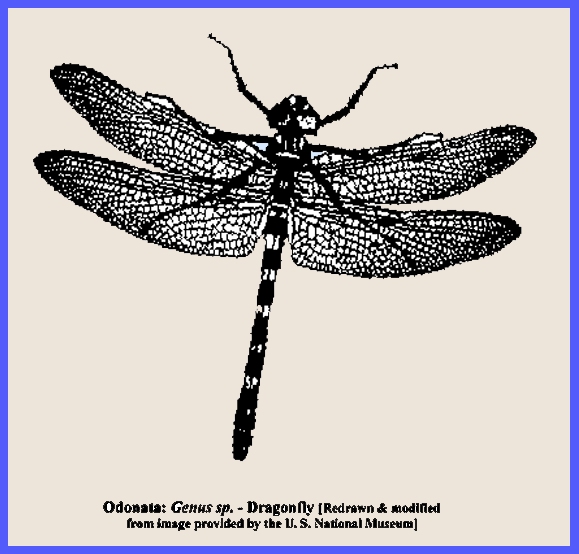File:
<odonata.htm> (Entomology),
(Invertebrates), (General Index)> <Invertebrate
Bibliography> <Glossary> <Site Description> < Home>
|
Entomology: ODONATA 1 Kingdom: Animalia, Phylum: Arthropoda Subphylum: Hexapoda: Class: Insecta: Order: Odonata (Contact)
Please CLICK on underlined
categories to view and on included illustrations to enlarge: Depress Ctrl/F to search for subject matter:
Odonata --
are predacious insects with biting mouthparts. They have two similar pairs of wings with characteristic
reticulate venation; prominent eyes and small antennae. The abdomen is elongated with accessory
male genitalia on the 2nd and 3rd sterna.
The metamorphosis is Hemimetabolous, the naiads are aquatic and they
have a modified labium known as the mask. There are two suborders, the Anisoptera,
where the naiads are without external gills but rather have rectal gills, and
Zygoptera,
where there are three prominent external and terminal gills. Fossil Record.
-- Specimens date back to over 250 million years. Although present day forms have a wingspread of about 13 cm,
extinct forms had a 3/4 meter wingspread.
Body Form.
-- They are all large insects, and in the Carboniferous period genera existed
which had a wing expanse of two feet. They are strong and rapid fliers,
catching their food, in the form of small insects, on the wing. The forwardly
directed legs play an important part in catching the prey and holding it
while it is chewed.
All the mouth appendages are
toothed, and the maxillae and labium augment the mandibles in chewing
capacity unlike most insects with biting mouthparts. They can inflict serious bites if
handled. The compound eyes of Odonata
are the largest of all insects, which gives them vision in multiple
directions. Thus, they are able to
escape avian predators and are difficult to catch with a net. Mating.
-- The process is quite unique for insects.
Although the male pore is on segment 9 of the abdomen, the copulatory
apparatus is found in the sternal region of segments 2 and 3. Before copulation, spermatozoa are
transferred to this structure. The
male then grasps the female in the region of the prothorax by means of his
posterior abdominal claspers. While in flight in this tandem position the
female turns her abdomen down and forwards and receives sperm from the
accessory copulatory structure of the male. Oviposition.
-- Dragonfly eggs are laid in water or on waterweeds. The naiads breathe with
tracheal gills and are of two kinds: (I) those with external gills in the
positions of cerci anales and caudal filaments and caudal filaments-Zygoptera,
(2) those with gills on the walls of the rectum- Anisoptera. In
the latter case water is pumped in and out through the anus, and this action
may be made use of in locomotion-the sudden expulsion of water causing a
rapid forward movement on the part of the naiad. However, the naiads on the
whole slow-moving creatures, lurking well camouflaged among waterweeds while
in wait for their prey. The main difference between the mouthparts of the
naiad and imago concerns the labium. In the adult this has normal
proportions, but in the naiad the post- mentum and prementum are elongated
and capable of being shot out rapidly from the folded resting position,
thereby impaling the prey, e.g., a tadpole, on the labial hooks.
============== |



